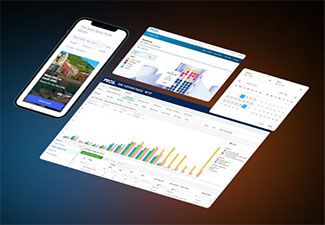Big Data Can Improve International Trade Performance
By Rob Glenn
January 27, 2013-
IN TODAY’S fast-paced global economy, organisations find themselves dealing with wide fluctuations in market demand and currency values. For companies whose businesses involve international trade, these dynamics have often outpaced their ability to properly understand the impact of raw material cost changes or how currency fluctuations can affect their margins and profitability.
To keep pace with and help manage the volatility of costs and currency fluctuations, more and more organisations are turning to a wealth of information now available to them in the form of what has been called “big data.” While used in a wide variety of contexts today, the term big data refers to the potential for unlocking insights into how businesses can improve performance at a very granular level. These insights can then be applied in taking action to address specific challenges such as maintaining profitability in an often unpredictable world.
In fact, a recent report from analyst firm Gartner states that companies who invest more fully in big data technologies than their competitors have the potential to outperform their competition by 20 per cent in every available financial metric. This sentiment is echoed in a recent article in Harvard Business Review that says companies in the top third of their industry in the use of data-driven decision-making were on average 5% more productive and 6 per cent more profitable than their competitors.
Harnessing the power
As one of the critical players in managing international businesses, the finance director has a key role to play in helping to harness the power of big data. By exploiting the potential of big data that in many cases is already being collected, the finance team can track and manage costs dynamically in near real time. This allows companies to manage the cost variations of raw materials across geographic regions, and adjust prices with greater frequency and in smaller increments to reflect local or regional market conditions. The same applies to currency fluctuations across global markets.
Along with responsibility for reporting results to executive management, the finance group is likely to be the only team with clear visibility into how international performance is being affected by changes in the economic situation. By mining insights into collected data, and working more closely with the chief sales officer, the finance director can help assure that the company is managing its sales most effectively across global markets.
Recent developments in information technology for manipulating big data provide finance directors with powerful new tools to understand and mold pricing strategy that were unheard of until recently. These advances give finance directors the ability to help their companies exploit the profit enhancement potential of pricing strategies across the spectrum of international trade – and literally put the power to optimise prices and better support their sales forces, thanks to innovations in pricing technology.
A November 2012 report from global analyst firm Gartner specifically speaks to how price optimisation technology can provide insights that leverage all the “big data” collected by CRM and ERP systems to enhance profits on several levels. The report notes that:
• Price management vendors and service providers have developed technologies and skills required to deal with complex data environments, and have successfully leveraged this insight to provide quantifiable improvements in revenue of between 2% and 4%.
• Price optimisation and management can provide critical visibility and governance to price management initiatives by linking big data with sales governance and oversight.
• Price optimisation utilizing modeling and forecasting can help identify and define optimal pricing strategies, along with developing dynamic price recommendations across different markets and customer segments.
• Pricing best practices can generate pricing guidance for pricing activities and deal negotiations by the sales force in diverse locations and markets. These best practices can also provide automated pricing administration to keep price lists and price books updated for diverse markets, as well as helping to automate ordering, quoting systems, and price approval processes.
Improving sales discipline and effectiveness
Big data analysis offers a means for companies to align sales operations, CRM applications and internal planning processes to help ensure consistently profitable pricing practices across multiple buying channels in international markets.
Advanced price analytics, for example, provide a practical means to harness the large volumes of customer transaction and related data captured by today’s ERP and CRM systems. This data can then be used to segment customers in diverse markets – with far more selective pricing options for products – based on shared customer behaviors. As a result, companies are able to get very specific about where and when to adjust prices.
Big data analysis can also leverage concepts such as determining an individual customer’s “willingness to pay” for specific products or services, based on both the customer’s peers and past purchasing behavior. Leapfrogging the typical spreadsheet or ‘gut feel’ approach to sales contract negotiations, companies can develop pricing strategies that help forecast or suggest a price elasticity range that will increase the odds of winning more deals more profitably. The resulting price guidance can be fed to field sales representatives via sales force automation tools to give them acceptable price ranges in negotiations, as well as helping control informal deviations from optimized pricing by discouraging excessive discounting, or misuse of incentives or rebates.
Executive management can also gain insight into an individual company’s value to the organisation by analysing customers in different markets, their prices and their relative ranking for revenue and profitability compared with each other. Using this information, sales management can identify low-performing customers and show sales teams the impact of price changes on company margins.
As organisations become more proficient in exploiting the potential of big data, executives can begin to identify new selling opportunities by analyzing historic and current buying patterns among existing or former customers, order volumes and purchasing patterns. Using that insight – together with insights gained from ERP and CRM applications – they are able to proactively identify new selling opportunities across channels and international markets. By integrating external market data with internal transaction information, companies can compare their prices with other suppliers in various markets and adjust their pricing strategies accordingly.
A strategic tool
As the uses of big data continue to evolve, it is rapidly moving beyond tactical applications to become a means of gaining strategic insights and forward-looking guidance for companies looking to expand their presence on the global stage.
Companies that take the initiative to explore and implement their big data potential will have a strategic competitive advantage over those that continue to rely on traditional ad hoc analysis methods and manual spreadsheets to manage the many facets of pricing.
The future belongs to those finance directors who evaluate technologies that leverage big data as an investment that can have a major impact on revenue, margins and profitability while helping to deliver a consistent and satisfying customer experience.
Rob Glenn is general manager EMEA at PROS





